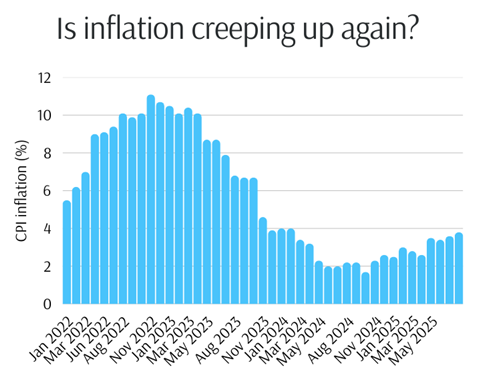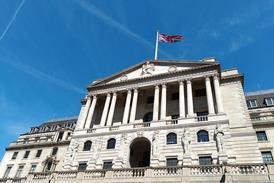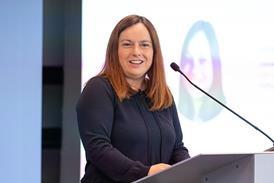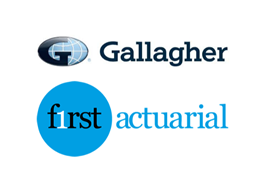Fewer defined benefit (DB) pension schemes are offering discretionary increases, research shows, even as the consumer prices index (CPI) is starting to creep higher.
A survey from Aon of more than 200 UK DB schemes found that 13% granted a discretionary increase in 2024, down from 17% the previous year. Just 12% said they planned to do so this year. However, an additional 9% said they were exploring providing additional benefits such as access to an independent financial adviser.
The consultancy group said lower inflation compared to 2022 could be a reason for the fall. CPI inflation fell from 11.1% in October 2022 to less than 2% in September 2024, but has since crept higher – see below.
Despite the fall, Nick Coates, associate partner and head of member distributions at Aon, said more pension schemes could consider granting increases in the future, given the government’s proposed changes to the rules around surplus release.
“It’s increasingly apparent that trustee boards and sponsors must clearly define decision-making responsibilities and engage in strategic planning around surplus use and equitable sharing.”
Nick Coates, Aon
The survey found that the funding level was a “considerable influence” on whether or not trustees chose to grant discretionary increases. All those that paid increases were fully funded on a technical provisions basis, while more than half (58%) were fully funded on a solvency basis.
Pre-97 benefits boosted through discretionary increases

Aon’s survey found that the most common way for pension schemes to use their surplus currently was to make payments to those with benefits accrued before 1997, which are not automatically uprated.
The Department for Work and Pensions has engaged with the Pensions Regulator about this cohort of pension scheme members, after the Work and Pensions Committee called for them to investigate how schemes had handled pre-1997 increases.
In its response to the committee, the government said it took the issue “very seriously” and recognised that affected members were “understandably concerned at seeing inflation erode the value of their retirement income”.
“Pension scheme trustees and sponsoring employers need to think carefully about the impact inflation has on members’ benefits when they are making decisions about benefit increases,” the government said.
Endgame planning and discretionary increases
Proposed changes to surplus access rules are also influencing trustee decision-making, according to Aon. More than half (61%) of schemes offering an increase planned to run on rather than immediately target a bulk annuity transaction. However, 83% of schemes said they had not decided how to share any surplus between the sponsor and members.
Coates highlighted recent guidance from the Pensions Regulator on endgame options for DB schemes, which recommended that trustees establish a surplus distribution policy if they plan to run on.
“As schemes have become better funded, there are complex issues for trustees to work through on when and how discretionary benefits are awarded,” Coates said.
“Simply retaining the surplus and building up more could lead to significant intergenerational unfairness among members. For example, if discretionary benefits are only awarded 10 years down the line, it will only be those still alive who can benefit – so the timing of the surplus release is important.”
He added: “Schemes may need to justify whether and how they apply discretionary increases or distribute surplus. Either way, it’s increasingly apparent that trustee boards and sponsors must clearly define decision-making responsibilities and engage in strategic planning around surplus use and equitable sharing.”
Inflation on the increase again as CPI hits 3.8% for July

Official data showed that CPI inflation ticked up to 3.8% in July, from 3.6% the previous month. While this is significantly lower than the recent peak of 11.1% in October 2022, inflation has been steadily increasing since the start of the year.
The Bank of England has forecast that inflation could hit 4% before falling again, which has led some to speculate that there may not be another interest rate change until 2026.
Lindsay James, investment strategist at Quilter, said: “The stagflationary environment facing the UK is getting further embedded. Growth, albeit better than expected, is back to being anaemic. The labour market is showing signs of strain, while bond yields are picking up again.
“The UK faces a moment of reckoning this autumn when Rachel Reeves will be forced to consider either her fiscal rules or her pledges not to raise taxes for working people.”
Lindsay James, Quilter
“The UK faces a moment of reckoning this autumn when Rachel Reeves will be forced to consider either her fiscal rules or her pledges not to raise taxes for working people, given the fiscal shortfall. Tax changes around the edges and a lack of deeper spending cuts appear to simply not satisfy markets any longer.
“All of this makes it incredibly difficult to predict the path of interest rates. The weak growth and fragile state of employment in the UK should enable the Bank of England to cut rates again at least once this year, but if inflation continues its march upwards and gets stuck at any point on the way back down, then policy decisions may need to be backtracked.”






















